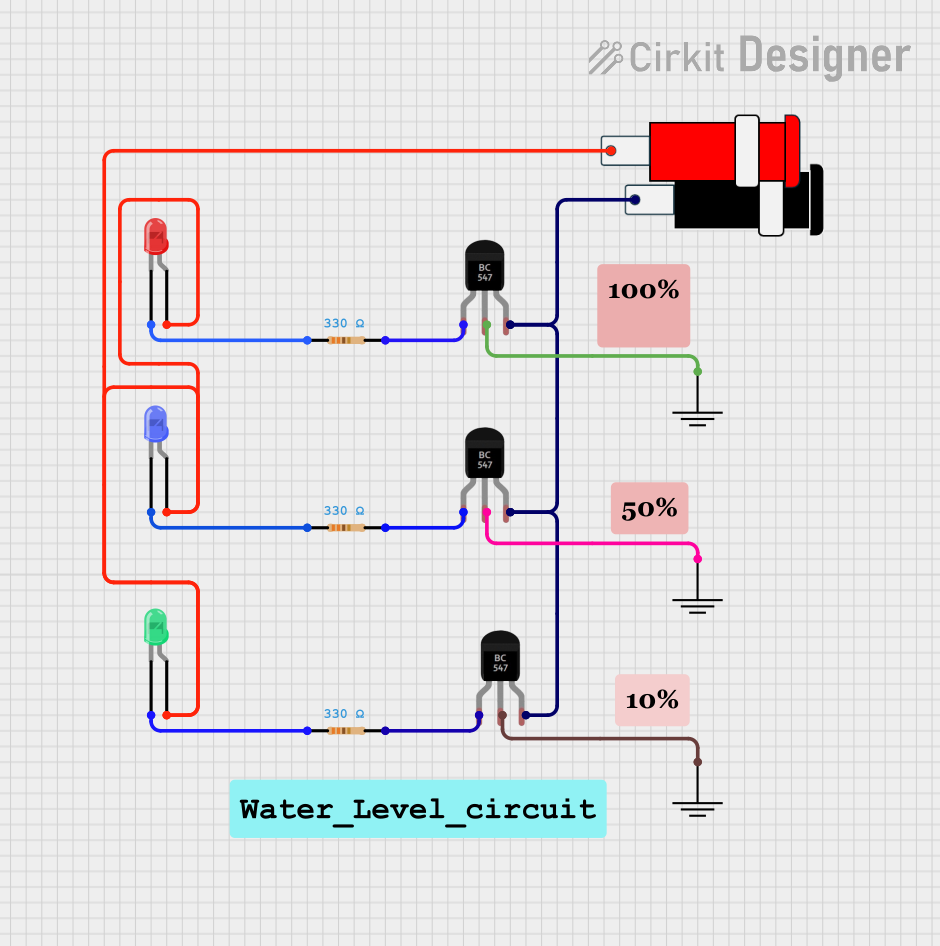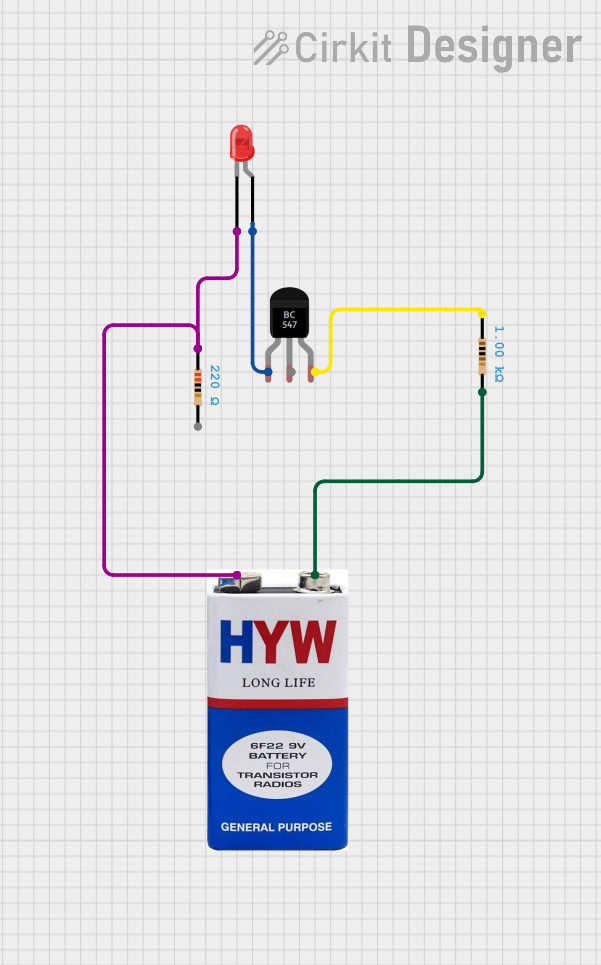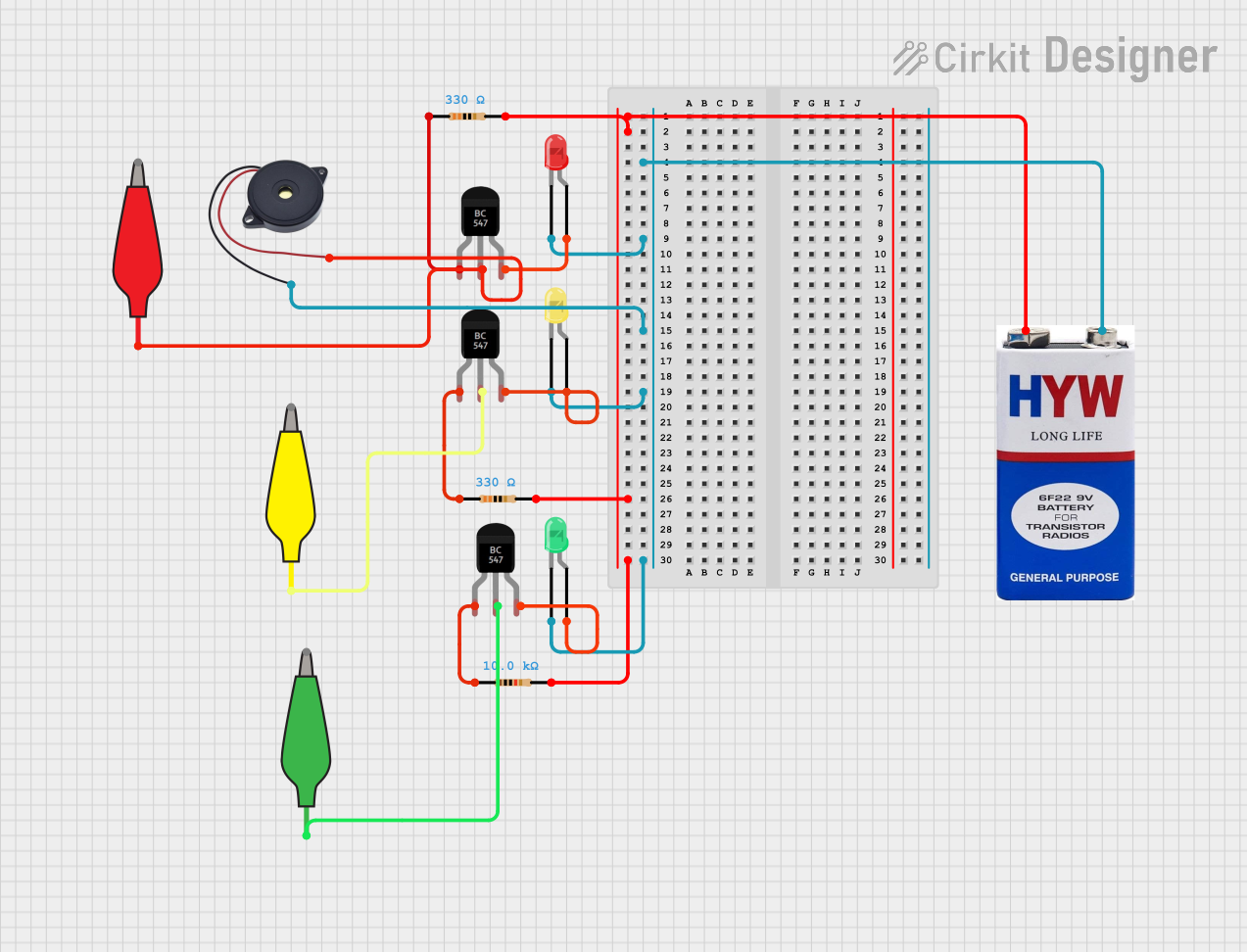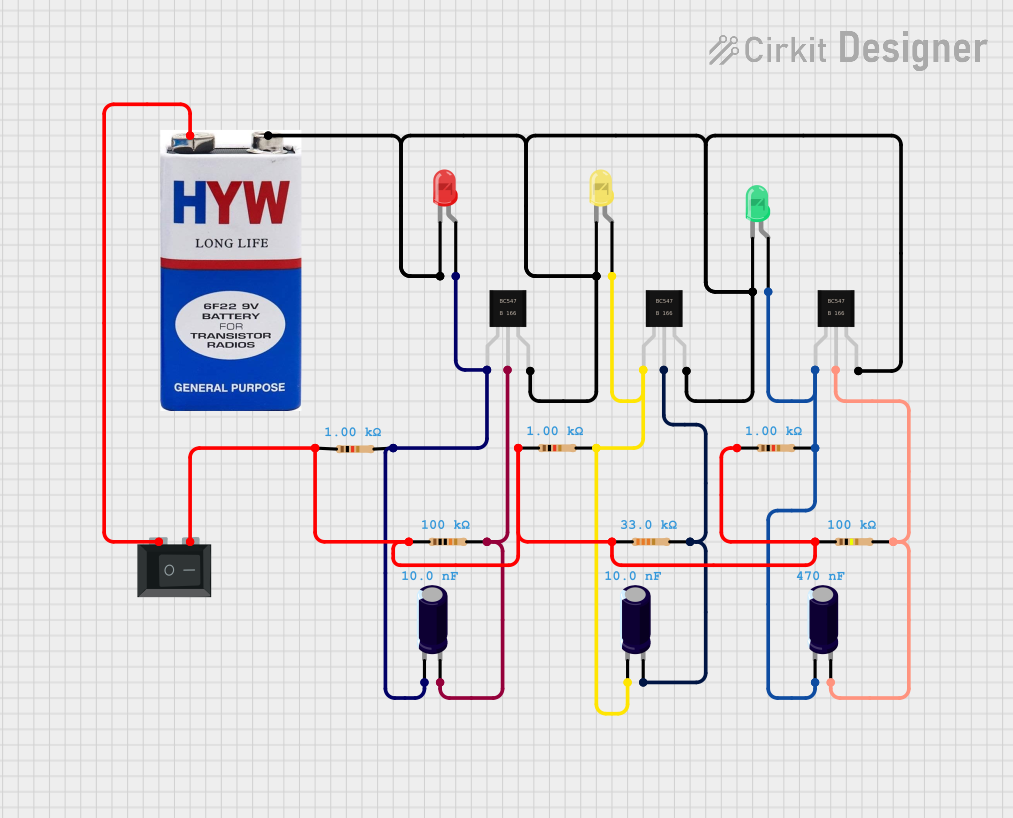
How to Use BC547 Transistor: Examples, Pinouts, and Specs

 Design with BC547 Transistor in Cirkit Designer
Design with BC547 Transistor in Cirkit DesignerIntroduction
The BC547 is a general-purpose NPN bipolar junction transistor (BJT) widely used in low-power amplification and switching applications. It is a highly versatile and reliable component, making it a popular choice for hobbyists and professionals alike. With a maximum collector current of 100 mA and a voltage rating of 45 V, the BC547 is suitable for a variety of small-signal applications.
Explore Projects Built with BC547 Transistor

 Open Project in Cirkit Designer
Open Project in Cirkit Designer
 Open Project in Cirkit Designer
Open Project in Cirkit Designer
 Open Project in Cirkit Designer
Open Project in Cirkit Designer
 Open Project in Cirkit Designer
Open Project in Cirkit DesignerExplore Projects Built with BC547 Transistor

 Open Project in Cirkit Designer
Open Project in Cirkit Designer
 Open Project in Cirkit Designer
Open Project in Cirkit Designer
 Open Project in Cirkit Designer
Open Project in Cirkit Designer
 Open Project in Cirkit Designer
Open Project in Cirkit DesignerCommon Applications and Use Cases
- Signal amplification in audio and RF circuits
- Switching small loads such as LEDs or relays
- Oscillator circuits
- Voltage regulation and current limiting
- General-purpose low-power electronic projects
Technical Specifications
Below are the key technical details of the BC547 transistor:
| Parameter | Value |
|---|---|
| Transistor Type | NPN |
| Maximum Collector Current (Ic) | 100 mA |
| Maximum Collector-Emitter Voltage (Vce) | 45 V |
| Maximum Collector-Base Voltage (Vcb) | 50 V |
| Maximum Emitter-Base Voltage (Veb) | 6 V |
| DC Current Gain (hFE) | 110 to 800 (varies by model) |
| Power Dissipation (Ptot) | 500 mW |
| Transition Frequency (ft) | 150 MHz |
| Package Type | TO-92 |
Pin Configuration and Descriptions
The BC547 transistor comes in a TO-92 package with three pins. The pinout is as follows:
| Pin Number | Pin Name | Description |
|---|---|---|
| 1 | Collector | Current flows out of this pin (output). |
| 2 | Base | Controls the transistor's operation. |
| 3 | Emitter | Current flows into this pin (input). |
The pinout diagram for the BC547 (TO-92 package) is shown below when viewed from the flat side:
_______
| |
| |
|_______|
| | |
1 2 3
C B E
Usage Instructions
How to Use the BC547 in a Circuit
Determine the Operating Region: The BC547 can operate in three regions:
- Cutoff Region: Acts as an open switch (no current flows).
- Active Region: Used for amplification.
- Saturation Region: Acts as a closed switch (maximum current flows).
Base Resistor Selection: To control the transistor, a resistor is typically connected to the base pin. The value of the base resistor (Rb) can be calculated using the formula: [ R_b = \frac{V_{in} - V_{be}}{I_b} ] Where:
- ( V_{in} ): Input voltage to the base
- ( V_{be} ): Base-emitter voltage (typically 0.7 V for the BC547)
- ( I_b ): Base current (( I_b = \frac{I_c}{h_{FE}} ))
Connect the Circuit:
- Connect the collector to the load (e.g., an LED with a current-limiting resistor).
- Connect the emitter to ground.
- Apply a small current to the base to control the larger current flowing from collector to emitter.
Example: Switching an LED with an Arduino UNO
The BC547 can be used to control an LED using an Arduino UNO. Below is an example circuit and code:
Circuit Connections
- Collector (Pin 1): Connect to one terminal of the LED (with a 220 Ω resistor in series).
- Emitter (Pin 3): Connect to ground.
- Base (Pin 2): Connect to an Arduino digital pin (via a 1 kΩ resistor).
Arduino Code
// Define the pin connected to the BC547 base
const int transistorBasePin = 9; // Digital pin 9
void setup() {
pinMode(transistorBasePin, OUTPUT); // Set the pin as an output
}
void loop() {
digitalWrite(transistorBasePin, HIGH); // Turn on the transistor (LED ON)
delay(1000); // Wait for 1 second
digitalWrite(transistorBasePin, LOW); // Turn off the transistor (LED OFF)
delay(1000); // Wait for 1 second
}
Important Considerations and Best Practices
- Avoid Exceeding Maximum Ratings: Ensure the collector current does not exceed 100 mA and the voltage ratings are not surpassed.
- Use a Heat Sink if Necessary: For prolonged operation near the maximum power dissipation (500 mW), consider using a heat sink.
- Protect the Base Pin: Always use a base resistor to limit the current and prevent damage to the transistor.
- Check Polarity: Ensure correct pin connections to avoid malfunction or damage.
Troubleshooting and FAQs
Common Issues and Solutions
The Transistor Does Not Turn On:
- Check the base resistor value. It might be too high, preventing sufficient base current.
- Verify the input voltage to the base pin. Ensure it is at least 0.7 V higher than the emitter voltage.
The Transistor Overheats:
- Ensure the collector current does not exceed 100 mA.
- Check for proper heat dissipation and avoid prolonged operation near the maximum power rating.
The Load Does Not Operate Properly:
- Verify the connections to the collector and emitter pins.
- Ensure the load's current and voltage requirements are within the transistor's limits.
FAQs
Q: Can the BC547 be used to drive a motor?
A: The BC547 is not suitable for driving motors directly due to its low maximum collector current (100 mA). Use a power transistor like the TIP120 or a MOSFET for such applications.
Q: What is the difference between BC547A, BC547B, and BC547C?
A: The suffix (A, B, or C) indicates the range of DC current gain (hFE):
- BC547A: hFE = 110 to 220
- BC547B: hFE = 200 to 450
- BC547C: hFE = 420 to 800
Q: Can the BC547 be used in high-frequency circuits?
A: Yes, the BC547 has a transition frequency (( f_t )) of 150 MHz, making it suitable for some high-frequency applications.
By following this documentation, you can effectively use the BC547 transistor in your electronic projects!